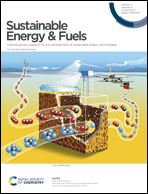Economic analysis of hydrogen production in Germany with a focus on green hydrogen, considering all three major water electrolysis technologies†
Abstract
Hydrogen will play a vital role in Germany's future energy supply. Because of that, the German government has issued a hydrogen strategy in 2020 to ensure the future hydrogen supply in Germany. Due to the increased interest in this energy carrier, this study investigates the LCOH for different hydrogen plants in Germany. For this purpose, different water electrolysis technologies and scenarios have been considered. The objectives of the study are, on the one hand, to find out which hydrogen technology causes the lowest LCOH for the different scenarios and what LCOH can be expected for green hydrogen in 2030 and 2050 if electricity prices are only 20 or 30 € per MWh, which are also compared to the production costs of blue and grey hydrogen. On the other hand, other objectives of the study are to find out how the change in wholesale electricity prices in 2022 compared to those in 2021 affected the LCOH and how the LCOH changes if an electricity price of 0 € per MWh is assumed. Furthermore, the results are compared and classified with the generation costs of other processes as well as results from other studies. The study concludes that the solid oxide electrolyser cell technology causes the lowest LCOH, except for the 4000 h_RE current scenario. If the electricity prices for green hydrogen production are 20 or 30 € per MWh, the LCOH decreases significantly and is in between 1.33 and 2.88 € per kg H2 (30 € per MWh) and 0.95–2.39 € per kg H2 (20 € per MWh). These values are competitive compared to those for blue and grey hydrogen. Compared to 2021, the LCOH has doubled or nearly doubled. Provided that an electricity price of 0 € per MWh is assumed, the LCOH decreases by about 35–99% (10 MW) and 45–99.5% (100 MW), with even some negative LCOH values due to the assumed revenues for oxygen. In addition, the results are in good agreement with those of other studies and are competitive with those of other processes at an electricity price of 20 € per MWh.



 Please wait while we load your content...
Please wait while we load your content...